- Lucky Day!
- Great Reads Without the Wait!
- LOL! Comedy Audiobooks
- Workers of the World Unite ... and Read!
- New Children's Read-Alongs
- Oh Mercy Mercy Me (The Ecology)
- Historical Romance by Authors of Color
- African-American Authors: Fiction
- Beach Reads for a Dead Sea Vacation
- So you've watched Bridgerton...
- See all ebooks collections
- Audiobooks Available Now!
- Stuff You Missed in History Class - Listen Alikes
- PCPL Staff Audio Picks: Bet You Can't Hit Pause!
- So you've watched Bridgerton...
- See all audiobooks collections
- Read a Magazine!
- Home & Garden
- Cooking & Food
- Fashion
- News & Politics
- Sports
- Celebrity
- Business & Finance
- Kids & Teens
- Science
- See all magazines collections

